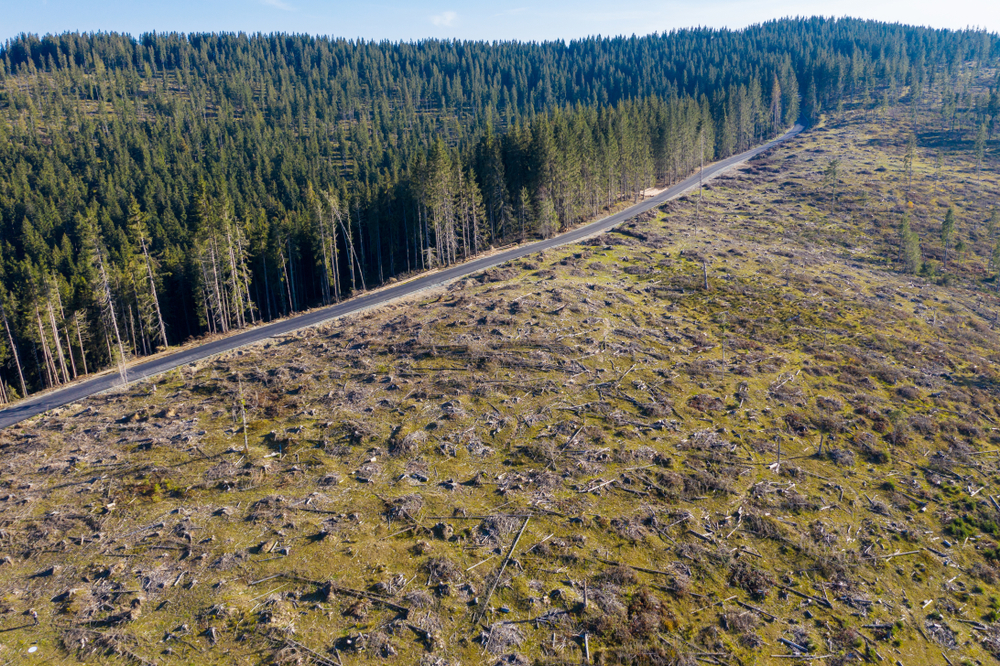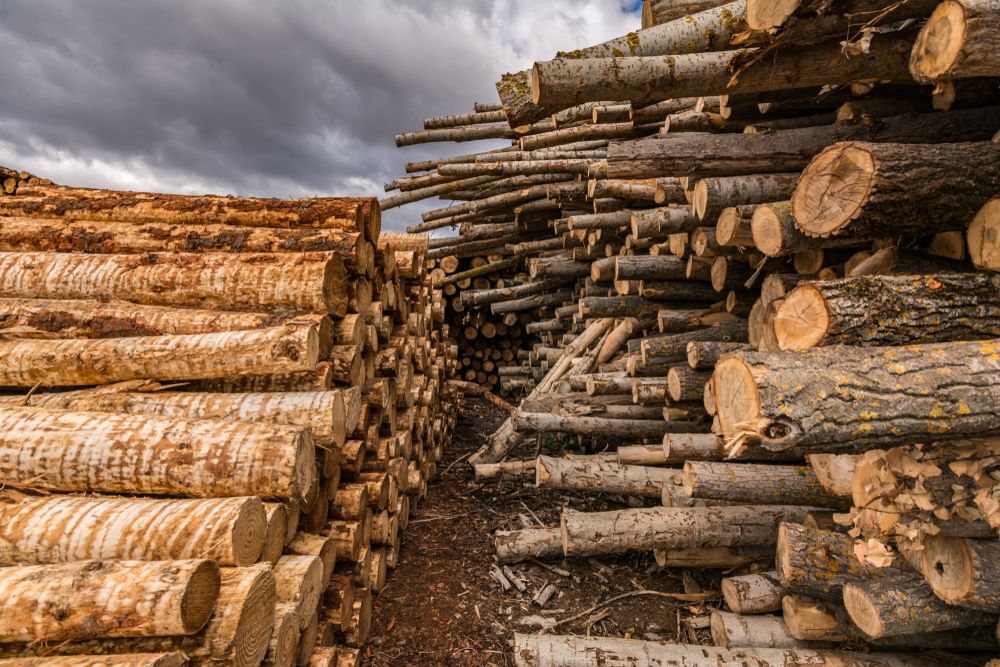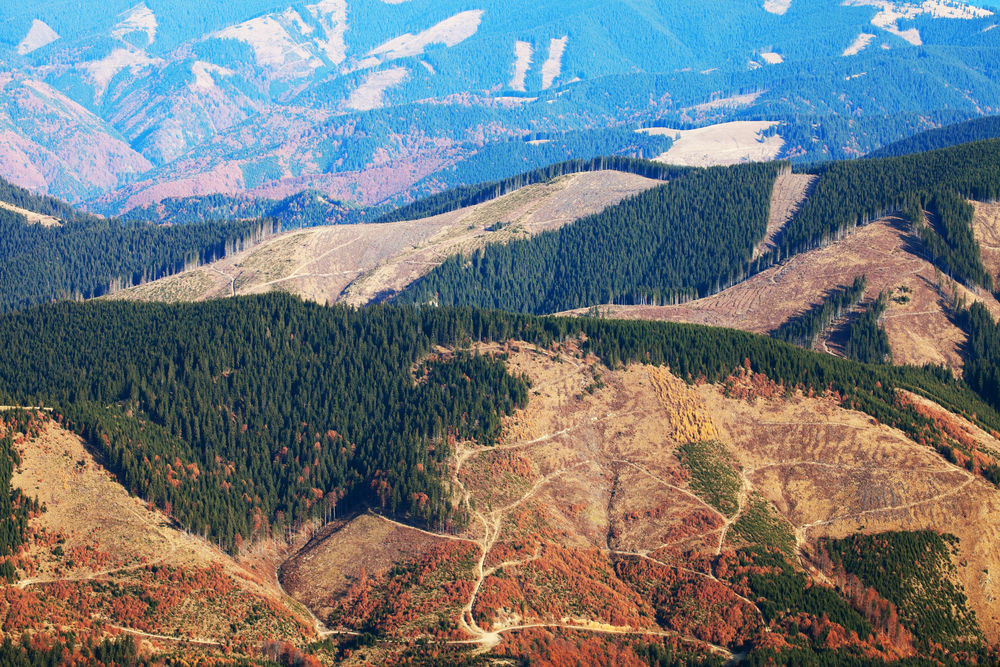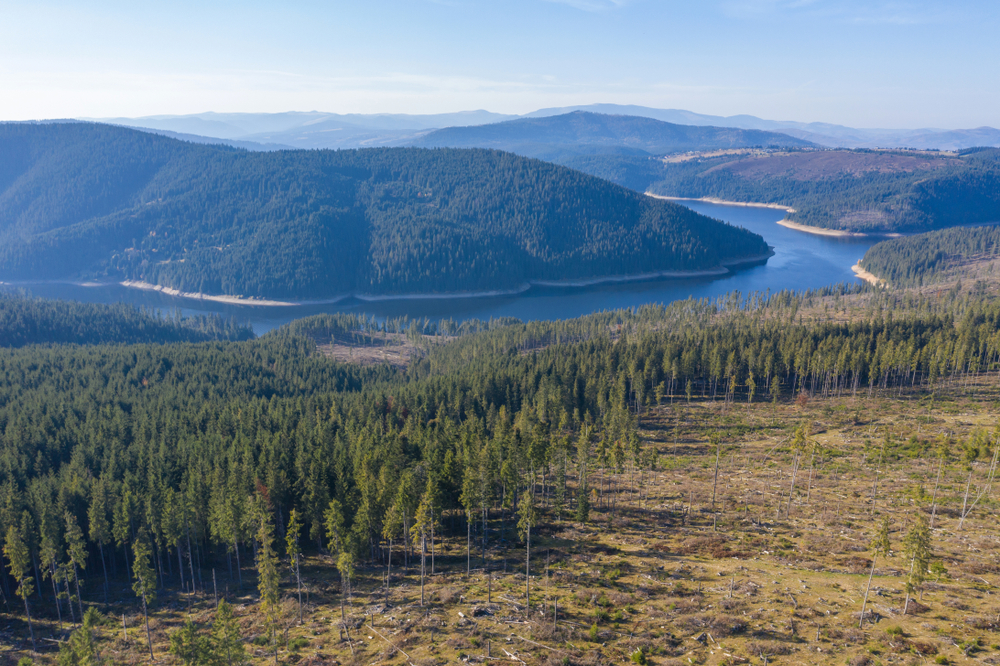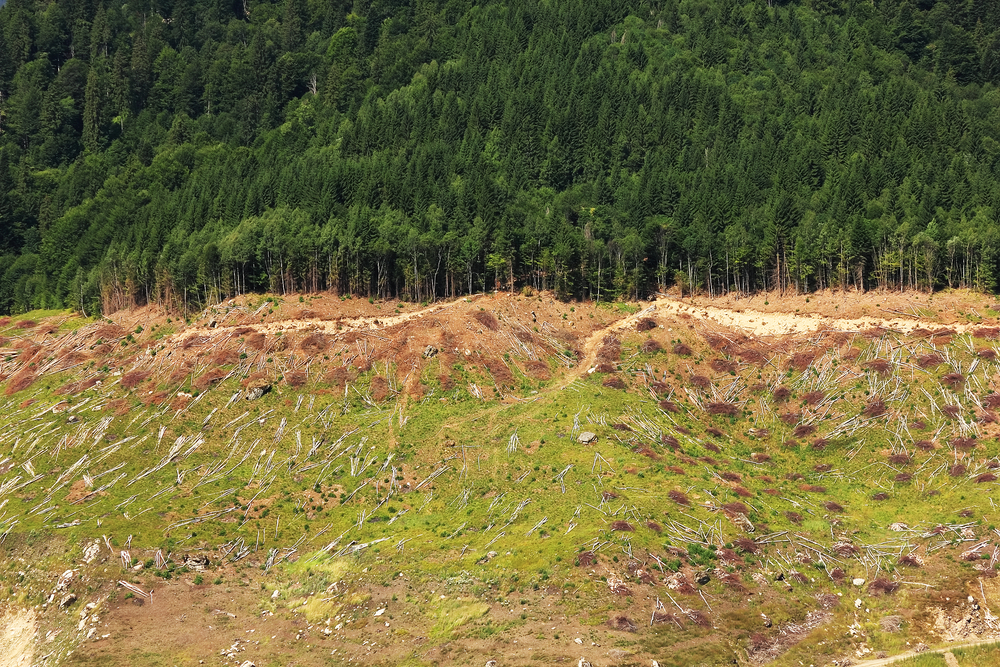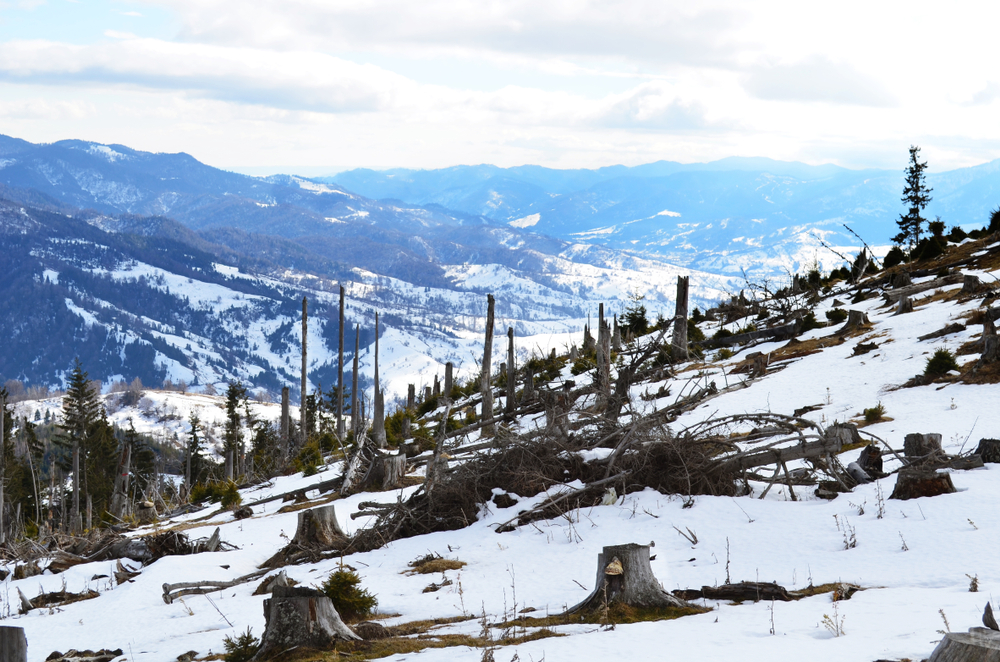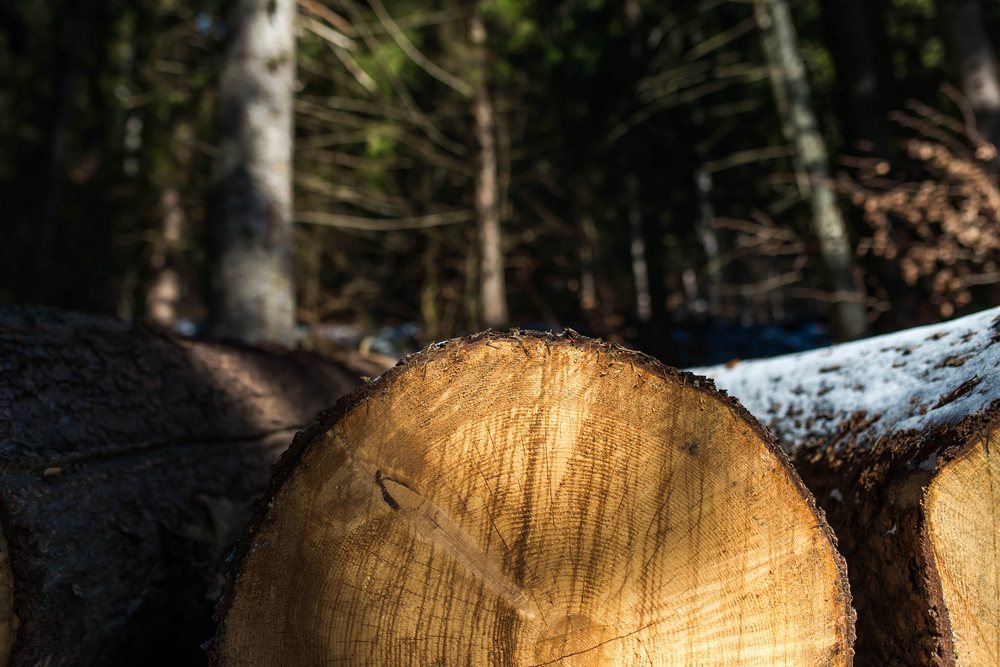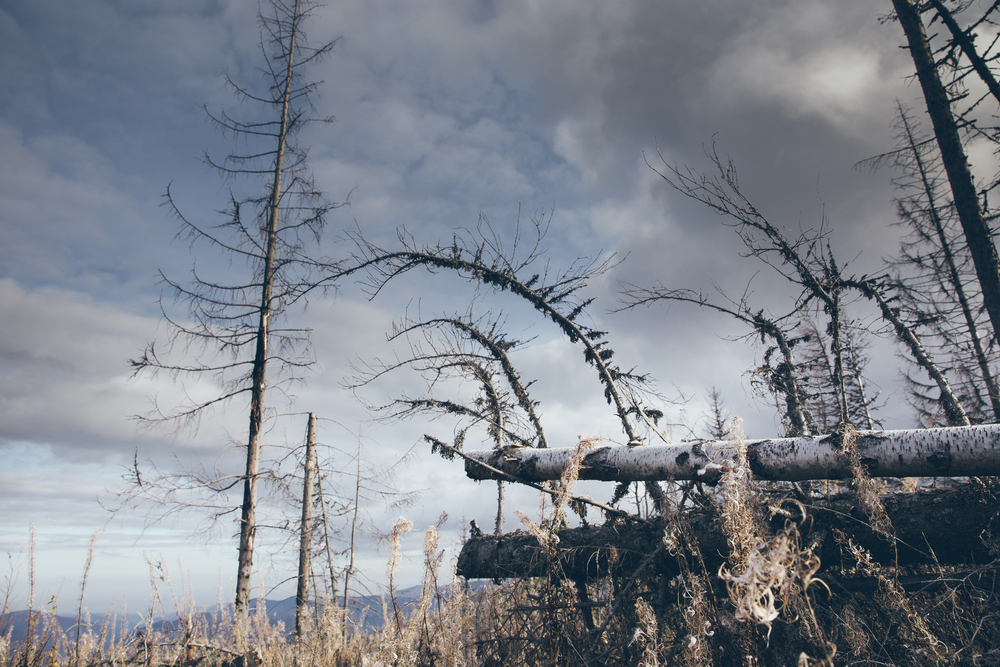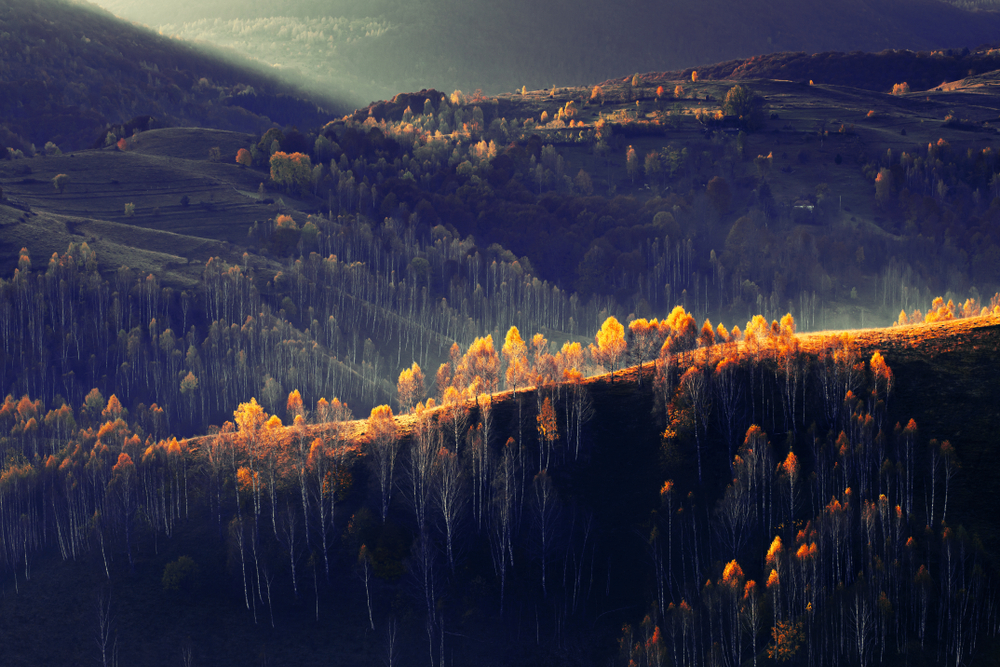Timber mafia and deforestation in Romania
Virgin forests in Central-Eastern Europe are the last remaining ones on the continent, yet they are being mercilessly torn down. Part of this multi-billion euro industry is a mafia-like system that stretches all the way from Romania to Ukraine. Austrian timber companies are right at the heart of it.
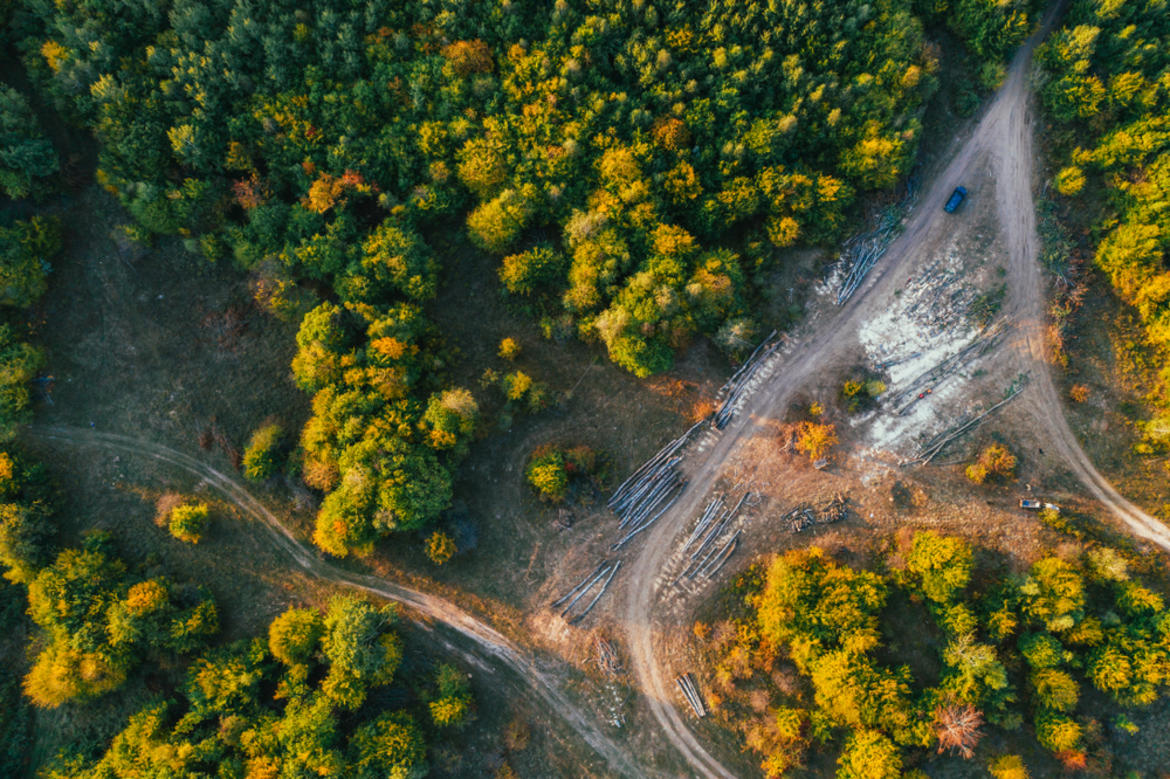
Logging activities in Romania (photo: © Beata Angyalosi/Shutterstock )
Timber mafia and deforestation in Romania
Virgin forests in Central-Eastern Europe are the last remaining ones on the continent, yet they are being mercilessly torn down. Part of this multi-billion euro industry is a mafia-like system that stretches all the way from Romania to Ukraine. Austrian timber companies are right at the heart of it.
Logging activities in Romania (photo: © Beata Angyalosi/Shutterstock )
EDJNet’s partner in Poland, BiQdata, has covered the destructive logging activities in the Polish primeval forest of Białowieza.
“Just watch out if you go into the forest on your own. It can be dangerous in there. Strange things can happen. Some people have never made it out again.” That is what they said to the lanky man in the glasses. He was threatening to tell all, to lift the lid on the whole system of illegally harvested timber and the trade in it. He himself was part of that system, but he was prepared to get out of it and risk everything as a result.
The Schweighofer system
The transformation of trees into boards involves a process of gigantic dimensions. Columns of articulated lorries deliver the logs to huge timber yards day and night. Here they are seized by gripper arms, measured by computer, and a worker in the driver’s cab assesses the quality of the wood. And then they are flung onto a conveyor, turned over and rotated, stripped of their bark, and fed into the sawmill machine. 40 tree trunks every minute, 2400 every hour, 28800 every shift. Romania’s biggest processor, a colossus in the sector, has an insatiable hunger for wood. And that processor is an Austrian, holder of the Silver Medal of Honour of the City of Vienna, owner of grand palaces in the heart of the city and a secretive man: Gerald Schweighofer. The business magazine Trend once published an article about his rise from humble beginnings in Lower Austria’s Waldviertel region, in which it referred to the 61-year-old as a “hard-as-steel timber baron”.
A Google search on “Schweighofer” and “Romania” produces less attractive-sounding results: in May last year the media were full of reports about raids on his sawmills carried out by the Romanian anti-mafia unit. Schweighofer staff stood accused of having formed an organised criminal group and being involved in illegal logging, tax fraud and unfair commercial practices. “Investigations into our former employees are still ongoing; we are assisting the Romanian authorities and will not be making any further comment,” says a man who seems to find it all rather embarrassing but who ultimately owes his job to the unpleasantness. His name is Michael Proschek-Hauptmann, since 2017 the public face of change at Schweighofer.
A company caught up in its own chipping machine
Responsible for compliance and sustainability, Proschek-Hauptmann is an acknowledged expert in environmental issues and has made the journey from Vienna specially in order to give Addendum a guided tour of one of the Schweighofer mills in the Transylvanian town of Sebeș. Until recently, any visits by journalists ended at the gate. It had even been known for activists who had followed the illegal timber trail this far to be pepper-sprayed by security staff.
But the newly decreed watchword is openness. For the Austrian company is under serious suspicion of involvement in the illegal logging of the last remaining major contiguous areas of forest in Europe. Schweighofer has been stripped of its prestigious Forest Stewardship Council (FSC) certification of sustainably produced timber. The 110-page report of the FSC investigation, which has been seen by Addendum, refers to “clear and convincing evidence” that Schweighofer was “involved systematically […] directly and indirectly, in the trade of timber which has been harvested and/or handled in violation of existing laws and regulations” and had associated “with individuals and companies with criminal and corrupt backgrounds”.
And this when what is at stake in Romania is a unique natural paradise that is even more important in the face of climate change, home to wolves, bears and lynxes, as well as to a host of plants that have long since died out elsewhere. And while climate activists are trying to reduce CO2 emissions through flight-shaming and demands for driving bans in cities, a single 150-year-old beech tree absorbs nine tonnes of CO2 – enough to offset a journey of 56,000 kilometres by car.
Yet these and even older trees are being indiscriminately felled. For these trees are also a business – a business that engenders greed that in turn leads to violence, threats and in one instance even attempted murder.
The arrival of the Austrians
No history of the depletion of the Romanian forests would be complete without the role of Austrian businesses and the families behind them. It is a role that leads to places of which Michael Proschek-Hauptmann, the benevolent face of the Schweighofer concern, is reluctant to speak. And it leads, too, to the question of responsibility – not just for Schweighofer, but for other Austrian companies too.
The names of these companies are not well known to the general public, even though they are world market leaders in their respective branches of the global timber exploitation chain. And even though no one directly employed by them ever fells a single tree themselves, they stand accused of commercial complicity in deforestation.
With the aid of satellite images, Global Forest Watch has calculated that 317,000 hectares of Romanian forest were lost to logging between 2001 and 2017. That’s the equivalent of 444,000 football pitches or twice the size of the Austrian federal state of Vorarlberg. Half of these trees were in national parks or conservation areas and were hundreds of years old. Experts from the Environmental Investigation Agency (EIA), a US NGO, investigate and expose the predatory exploitation of nature throughout the world. “Whether it’s in America, Asia or Africa, people are appalled at the way our planet is being destroyed. But while the deforestation of the Amazon rainforest has been horrifying people for years, hardly anyone realises that Europe contains remnants of virgin forests that are just as important. The fact that the majority of these are on our doorstep, in the Carpathians, and are under threat remains an untold story,” says the EIA’s David Gehl. The EIA reports accuse Schweighofer of having been the “biggest receiver of illegal timber” and having “lied about the source of its products for more than ten years”.
260 million felled trees
The giants in the timber sector must have thought they had hit the jackpot when they first discovered a new Eldorado for themselves: Romania, one of the poorest countries in the EU. One of those giants was Schweighofer. From 2002 onwards it started selling its sawmills in Austria, taking its profits (reportedly in nine figures) and using them to build vastly bigger structures in Romania. Romanian politicians welcomed the arrival of the Austrians. It would, after all, prevent the thousands of tiny sawmills across the country forming conglomerates whose owners might have decided to take a political hand themselves. Schweighofer now has more than 3000 staff, a turnover of 762 million euros and five factories in the country, producing pellets and sawn, glued and profiled timber that it sells throughout the world, including in Austrian DIY stores.
There is also the Kronospan company. Part of the Salzburg-based Kaindl industrial dynasty and with an annual turnover of more than two billion euros, it is the world’s biggest manufacturer of wood-based panels, numbering Ikea among its customers. Together with their Swiss sister company, Swiss Krono, the Kaindls are one of the main players in the Carpathians as a whole.
And finally there is also their competitor, the Tyrolean company Egger, owned by brothers Michael and Fritz Egger, who have built up a global concern with 18 sites in eight different countries. As suppliers to the furniture trade, the timber trade and DIY chains, they too set up in Romania. It is no coincidence that both Kronospan and Egger built their factories right next to those owned by Schweighofer. To this day they remain part of the same exploitation chain, obtaining wood shavings and wood scraps from Schweighofer for further processing into panels, so they are all interconnected.
Once they had staked their various claims and signed contracts, and the notoriously corrupt Romanian state forestry company, Romsilva, had issued their logging licences, they could get started – since the arrival of the Austrians in 2003, some 260 million Romanian trees have been felled.
Threatened and beaten up
“We want nothing to do with any of that. We do not kill virgin forests,” Schweighofer’s sustainability manager, Proschek-Hauptmann, stresses right at the start. He nimbly dodges every attempt to raise the subject of the company’s past, preferring to present reports, show figures, point to the company’s specially developed GPS truck-tracking system. This system is supposed to verify the source of every single tree and substantiate Schweighofer’s apparent reformation into a company that no longer accepts timber from national parks.
The longer we listen to him and the further we follow him through the enormous production plant in Sebeș, the more inclined we are to believe him. Or would be, at least, if it weren’t for the men who risked their lives to prove how the Austrian timber giant conducted itself before it adopted its apparent transparency. Andrei Ciurcanu is one such man. Powerfully built, he could have been a logger himself had he not decided to dedicate himself to tracking down the people who were destroying his homeland forests. Ciurcanu spent many hours struggling through the wilderness, many days on the lookout, and many months documenting the manoeuvres he had witnessed. He also made many of the horrifying films showing today’s moonscapes where forests of mighty giants once stood.
He and Gabriel Paun, his boss at the environmental protection NGO Agent Green, were threatened and beaten up by persons unknown. On one occasion the brake cable on their car was cut. Another time Paun was sent an email purporting to be from Florian Klenk, editor-in-chief of Falter, an Austrian weekly news magazine. Unsuspecting, he opened both the email itself and the file attached to it, only to find that it was not from Klenk at all but was actually a virus attack that wiped six gigabytes of data from his computer and then prevented him from re-starting it. Paun and Ciurcanu have since become extremely careful when carrying out their research.
“Right from the start, Schweighofer built its entire business model on the legal purchase of illegal timber. They knew it, they tolerated it, and sometimes they actually encouraged it. And it’s not just me saying that: it has been confirmed by investigators from the Organised Crime Unit,” said Ciurcanu, speaking in Bucharest before Addendum’s visit to the Schweighofer plant. “And now, all of a sudden, they want us to believe they’ve turned ‘green’?” Ciurcanu stresses each letter to make it clear that, after all these years, he simply doesn’t believe them.
On the trail of the timber
Where does the timber really come from? Ciurcanu points to his most recent investigations which, he says, show that only the Schweighofer modus operandi has changed. Many suppliers do not deliver the timber to the sawmills straight from a commercial forest, but instead take it to storage yards, some of them on the edge of the national park. There they are able to mix legally and illegally felled timber together, before it is declared clean and supplied to the timber giant. In the case of Schweighofer, he says, this allows them to bypass the GPS truck-tracking system, since that only records the journey from the storage yard to the sawmill. Moreover, Schweighofer continues to purchase timber from suppliers who log in national parks, merely requiring them to keep this national park timber separate from the rest at the storage yards.
Back in the Schweighofer plant in Sebeș, Michael Proschek-Hauptmann has managed to pack his two years’ activity as sustainability manager into a two-hour guided tour. He has denounced the corruption in the country, praised Schweighofer’s security systems and persuasively argued that the company is making a genuine effort to rectify the mistakes of the past.
As recently as 2015, however, the EIA secretly filmed a meeting between a Schweighofer manager and some people posing as potential suppliers at which the manager was apparently willing to accept timber from dubious sources on an extra-contractual basis. Proschek-Hauptmann challenges this: “The only thing the manager in question admitted in this film was that he would accept quantities over and above those specified in the contract. That is common practice in the timber industry.” He goes on to say that the manager had made a sworn statement to Schweighofer, confirming that the discussion had not gone off in any other direction. So it is rather astonishing, then, when Proschek-Hauptmann goes on to say that the company – which says the manager did nothing wrong – nevertheless terminated his employment.
Proschek-Hauptmann claims to have everything in hand where the controversial timber storage yards are concerned, too. “These are strictly regulated facilities: they keep registers, they record deliveries, and everything can be checked.” According to their own figures, though, nearly half of Schweighofer’s Romanian timber, which also goes to the neighbouring Kronospan and Egger companies for further processing, does not come direct from the forests but from storage yards like these. For this reason, the EIA says it is naïve of Austrian companies in this often criminally corrupt environment to suddenly put their faith in the honesty of their Romanian suppliers. The environmental agency accuses them of continuing to do business with companies that are still illegally logging in the national parks.
Proschek-Hauptmann hesitates for a moment, then says, “We have developed internal control systems and introduced a requirement for every storage yard operator to be visited by us at least once a year, and more frequently if there are any suspicions about them.” According to Schweighofer, this policy has recently led to the suspension of eight of their 650 or so suppliers. Yet even now, the company’s GPS tracking system is unable to monitor the source of each individual log in half of its Romanian timber.
Little action, much wood
It is late now in Sebeș, the small Transylvanian town that is host to two Austrian timber companies next door to each other: Schweighofer and Kronospan. Matthias Schickhofer is in town. He comes from Lower Austria and is a photographer with several books to his name. In them he portrays the beauty of Europe’s last remaining virgin forests and describes the threat they face. Working with Euronatur, a German conservation foundation, he has been focusing on Romania for a long time now and is currently organising a scientific conference here on the protection of virgin forests. For even though two-thirds of the surviving virgin forests of Central Europe are located in Romania – as much as 200,000 hectares – only about one-tenth of this amount is under any kind of protection.
To illustrate the problem, Schickhofer opens Google Earth on his computer. He flies over the densely forested Carpathian Mountains on his screen and zooms in. Where just a few years ago there was still dense beech forest, there are now huge gaps, looking like brown stains in the midst of the green. “All of this cleared land lies within national parks or the Natura 2000 nature protection network,” he says. “The state forestry authorities seize on any small-scale bark beetle infestations or storm damage as an excuse to clear whole hillsides one after another.” He fast forwards on the screen to bring up the latest satellite images of the area – and suddenly, where once there was virgin forest, now there is nothing. The brown patches used to be just scars on the forest; now they are all that is left – a single brown patch of bare land.
“Brussels should be exerting real pressure to stop the conglomerate of state forestry departments, old networks and corrupt clans destroying the last remnants of these virgin forests. It worked in Poland, where the European Court of Justice stopped the logging of the Natura 2000-protected Białowieża Forest by threatening heavy penalties.”
In a Transylvanian night
For corruption to work, there always has to be someone offering money and someone else pocketing it. An over-simplification, perhaps, but the truth of it becomes clear in the course of this night on the outskirts of Sebeș. Our host was recommended to us. He is a Green on the local council. In his black BMW X5, complete with leather seats, he guides us through the dark to his home. First he has a fine meal prepared for his guests, then he starts to rail against the Austrian companies in the town, and later he tells us about his own company in France and his special role on the municipal council. “There are nine Social Democrats, nine Liberals – and me.” He grins briefly: “They need me for every vote.”
But the solitary Green on the council has done nothing in all those years, Ana Haţegan tells us indignantly. She is standing by a busy road, with articulated lorries laden with enormous tree trunks thundering by. They’re heading for the gates of the Austrian chipboard manufacturer, Kronospan. From its chimneys, dense clouds of smoke rise into the sky. Ana is afraid of them. For this is where the company produces formaldehyde, used for gluing the chipboard. Above a certain concentration, the chemical is classified by the WHO as a carcinogen.
When cancer came to town
“Our campaign group has been fighting this for more than ten years: we’ve organised protests that half the town took part in. This is a residential area, there are children living here, and we have no reason to trust the official measurements,” Haţegan explains. She goes on to say that Kronospan was allowed to build its factory, which produces 30,000 tonnes of formaldehyde every year, without any kind of environmental impact assessment. “Our authorities are filled with people who bend easily and are part of the old system.” When Romania was taken to the EU Court of Justice for this breach of environmental regulations, it felt at first like a partial victory. But then Kronospan announced it was planning to double its formaldehyde production in Sebeș and was buying a decommissioned plant from France for the purpose. “The air was already terrible back then, wastewater was going into the river and we went back onto the streets. We filed lawsuits and demanded independent measurements, since the authorities were actually trying to tell us that the emission values would stay the same, even though production was being doubled.”
What Haţegan is describing is the exhausting battle of ordinary citizens against a global concern that has the backing of local politicians and can therefore overcome every obstacle. She shows us documents from the district hospital. These seem to show there has been a surge in the number of respiratory complaints and that a large proportion of local residents are affected. Further investigations revealed that Sebeș also has more cancer cases than the district average. “You keep running and running,” says the petite Ana Haţegan, “you keep fighting, you obtain documents, you read up on everything so you at least stand a chance of getting complex procedures started, and still you don’t get anywhere. They told me they’d need a whole year’s worth of independent measurements that would cost 10,000 euros. Where am I supposed to find that kind of money? In 2017 there was an explosion in the Kronospan plant, and even that didn’t make any difference. We go on breathing in air that’s making us sick.”
Barred gates at Kronospan
Matthias Schickhofer has been watching the entrance to the Kronospan plant the whole time Haţegan has been speaking, and he is appalled. A long queue of articulated lorries has formed, all of them full of logs, mostly thick beech and oak, all destined for the company’s enormous storage yard. “Logs like this have almost certainly come from old, quite possibly virgin, forests,” he explains. “Kronospan claim they don’t use any timber from virgin forests, national parks or other protected areas, but when I look at this storage yard I am extremely suspicious. One lorry driver just told me that the big beeches on his truck have come from the Tarcu mountains – a Natura 2000 protected area. There are remnants of virgin forest there, and there’s a lot of logging going on there.”
Unlike Holzindustrie Schweighofer, which agreed to a site visit and was willing to answer our questions, Kronospan was not prepared to meet with us. Last year they refused to allow Green MEP Thomas Waitz to view their premises. The Addendum request is turned down by David Brenner, who works for both the Kaindl family and Kronospan in Germany: “Unfortunately there is a date clash, since we will be holding a management meeting in Slovakia then,” he tells us on the phone. A former deputy governor of the state of Salzburg, Brenner was once considered the Social Democratic Party of Austria’s great hope for the future – until 2012, that is, when, as State Finance Director, he was tripped up by a series of swap deals that went wrong. After 340 million euros had been lost through speculation, Brenner announced his resignation and took up a post with Kronospan instead. Kronospan, according to an email from its Romanian manager, “respects all statutory regulations, both national and European, and cooperates with the authorities and civil society where it is necessary and desirable to do so.”
The company did not respond to the allegations contained in this article, however. Despite several extensions to the deadline, a request from Addendum remained unanswered. Shortly before our publication deadline, David Brenner finally got in touch to say that the company preferred to make no comment.
“We will kill you”
To truly grasp the scale of the illegal logging, it is worth looking at unpublished figures leaked to activists at the end of last year. They come from the classified Romanian forest inventory and show that some 38.6 million cubic metres of timber was taken from the forests between 2014 and 2018. The quantity legally permitted under forest utilisation plans was just 18 million cubic metres. This means that the total amount felled was twice the legal limit and that 20 million cubic metres of it was what can only be called mafia timber.
We need to find someone who can put this into context. Someone who knows how the system works in practice. Someone who knows it from the inside: who used to be a part of it. Our search takes us deep into the forest. Waiting for us between the trees is a tall, lanky man with glasses: Mihail Hanzu, a qualified forestry engineer who used to be Forestry Inspector for a municipality near Sibiu. What he experienced there is the story of Romania’s forests written in the 8000 hectares under his care. “It took two months for me to become suspicious, four to become certain, and six for them to threaten to kill me.” Hanzu’s mistake? He lifted the lid on the trade’s most important secret: how illegally felled trees are turned into legal timber, and how those involved can make millions from doing so.
“It was a whole system, from the mayor to my colleagues in the forestry department. I found more than 50 ways they were going about their fraud. The most common one was by deliberately understating the volumes. They mark a tree for felling. Write in the documents that it measures 18 metres, even if it actually measures 40, and that it has a diameter of 25 centimetres, even if it is actually 50. There is a great deal of money in that difference, and that money flows into their system. The municipality issues a licence for the logging, the companies sell the timber to middlemen, who store it in their timber yards and later deliver it to the sawmills along with all the necessary legal declarations. In our case, much of it went to Schweighofer.”
Mihail Hanzu, a man of integrity, was horrified when he realised the scale of the fraud. He secretly crept into the forests, took measurements and discovered huge areas that had been illegally cleared. In the end he refused to go on signing the documents covering up the scam. “There we were, in the forest, standing right in front of illegally felled trees. Me, my boss, another forestry inspector and the local police officer. I said I wasn’t going to have anything more to do with it.” His colleague turned to him and hissed: “If you don’t do it, I’ll find a couple of gypsies who’ll kill you in the forest.”
“If this isn’t a mafia, what is?”
Further threats followed, along with psychological pressure and the fear that each new day in the forest could be his last. Until finally, Hanzu had had enough. He handed in his notice and went to the investigators, intending to reveal everything and put a stop to the system, which was estimated to have siphoned off eight million euros in a single decade in his small municipality alone. The criminal investigators had a camera in their office that was recording everything. Suddenly a woman came in and told them to continue the interview in another office. So they went out into the corridor, where Hanzu and the official were alone and unobserved. Then the official said to him, “We don’t have another office. Get out of here!” For a long time after that, nothing happened. By chance, Hanzu saw an anonymous letter addressed to the Forestry Minister, defaming him in true Securitate style as “a danger to society” and “mentally ill”. It was only later that everything Hanzu had alleged was proven to be true.
When we ask him if this system is just an isolated example or part of a wider mafia outfit, he pauses briefly in his quiet manner before replying: “If this isn’t a mafia, what is? It’s an organised crime network that is destroying huge swathes of forest, is making itself extremely rich in the process and has long since passed the point where it could be stopped.” Mihail Hanzu is a whistleblower, someone who has told all because he loves the forest, has studied it, understands its importance for the climate and wants to see it saved. Asked about the role played by the Austrian companies in this system, he finds it hard to believe their assurances. “They’re the ones pumping the money into this system. They couldn’t stop it now, even if they wanted to: it’s too big, it stretches right across the country. But these companies knew what was going on here when they came to Romania. You don’t come here to run an honest business. If that’s what they’d wanted, they could have stayed in Austria.”
The poisoned forestry minister
Viewed like this, the destruction of the natural environment and the ecosystem is just collateral damage, a by-product of greed. Anyone posing a threat to this system needs to be prepared for the worst, whether they are an environmental campaigner, a forestry inspector … or even a government minister.
At the beginning of January 2018 the Romanian forestry minister, Doina Pană, suddenly resigned out of the blue. Until then she had been trying to take rigorous action against the illegal logging trade. It was said she had suddenly fallen ill, there were rumours of cancer. The truth was only made public a few weeks ago. The former minister had remained silent all that time because she was afraid of harming Romania’s image. But now she gave an interview in which she explained how, in the autumn of 2017, she had suddenly felt more and more unwell, had palpitations, how the doctors had been at a loss to explain it and she was afraid she would die. So she resigned. It was only after her resignation that comprehensive tests and a toxicological report delivered an incredible verdict: the minister had probably been poisoned with high doses of mercury over a long period of time.
In an interview with the online platform Ziar de Cluj, the politician, now fully recovered, said it had to have been the timber mafia behind the attempt on her life. The new conditions she had imposed had made illegal logging more difficult and the cartels had made “huge losses” as a result. She also points to the monopoly law she had introduced in an attempt to restrain Schweighofer, which had made it harder for the giant to buy logs: “This change in the civil law alone cost Schweighofer 150 million euros per year. This sum was also cited in a letter they sent to the then Prime Minister, Victor Ponta. But I still went ahead with the new measures. It didn’t make me popular with them, of course – obviously, it didn’t make me popular with them. I could see they were using every means at their disposal to discredit me, but I never thought they’d go that far.” Doina Pană did not want to say any more about her allegation to Addendum, since investigations are still ongoing. Schweighofer told Addendum her allegations are “absurd” and that it reserves the right to take “legal steps”.
Mafia timber and the EU
Meanwhile, the Austrian giants in Romania have a problem: the timber is running out. Schweighofer claims it is already having to import more than half the timber it needs, and puts the blame on Romanian bureaucracy. Activists, however, suspect that the real reason is that media pressure, stricter legal regulation and the ongoing police investigations are making it harder for Schweighofer to go on obtaining timber from various sources. At all events, the raw material is now being imported in large quantities from countries such as Slovakia or the Czech Republic, for example.
“But the tracking system developed by Schweighofer for Romania does not work at all with imports, which means that, yet again, it is almost impossible to trace the source of the timber. That is worrying, since large-scale logging is currently going on in Slovakia, too. Parts of the High and Low Tatras have already been destroyed, and the national parks are no more off-limits there than they are in Romania,” warns Johannes Zahnen, a forestry expert with the WWF. He cannot understand why the 2013 EU Timber Regulation is still not having any effect, given that it was supposed to stop the illegal timber trade in the EU altogether. “The USA is imposing multi-million dollar fines, and the EU Regulation also explicitly recommends similar fines as a deterrent, yet we have a lot of people investigating illegal logging but apparently finding nothing. Various NGOs provide a lot of tipoffs, but even then, very little is done. EU states are only implementing the Regulation very patchily.”
A Ukrainian dream… of Belize
Until fairly recently Ukraine, too, was considered an important supplier country. The tracks of the Ukrainian wide gauge railway run practically to the doors of the Schweighofer and Egger works in Rădăuți, in the north of Romania. The environmental organisation Earthsight discovered that Schweighofer alone was taking delivery of 80 railway wagons full of timber every single day. The Kaindl family recently opened a new chipboard factory in Hungary, right on its border with Ukraine.
But in the Ukrainian Carpathians, too, there are now enormous deforested areas. The Ukrainian state forestry authority is proving to be just as corrupt as its Romanian counterpart. Its former head used to play tennis with the former President, Viktor Yanukovych, and was especially creative when it came to taking bribes. “In order to keep the timber well below the market price, foreign companies were willing to make payments to letter-box companies registered in Belize and Panama in the name of his wife,” says Tara Ganesh of Earthsight. “The head of the forestry authority is accused of having pocketed bribes from four timber companies to the tune of 13.6 million euros between 2011 and 2014 – and one of those companies was Schweighofer.” According to investigative documents drawn up by the state prosecutor’s office in Kiev-Pechersk, Schweighofer was the biggest purchaser of Ukrainian timber at that time. Purchasing is believed to have been handled by Schweighofer’s Slovakian joint venture partner, Uniles s.r.o, which also made the payments to the dummy companies. Schweighofer itself “strongly denies” having been involved in bribery and claims to have “found nothing of that kind” in an investigation of its Slovakian subsidiary. It adds that it had not been possible to establish whether Uniles had a business relationship with the dummy companies in question, and that Schweighofer would be prepared to cooperate with the Slovakian authorities if they decided to initiate investigations.
More mafia timber from the Carpathians than from the tropics
When Yanukovych was overthrown in 2014, the head of the forestry department also disappeared and remains a fugitive. There is a warrant for his arrest, and the court case against him has been opened in his absence. Since then, the full extent of the deforestation in the Carpathians has become known. As a result of public pressure, Ukraine imposed an export ban on logs. This posed huge problems for purchasers, especially the large-scale ones on the other side of the Romanian border, who responded by hiring lobbyists to put pressure on Kiev at the EU level to lift the export ban. “Ghost trains” with false papers and full loads of logs found their way across the border at night. And a forestry director was caught red-handed offering police officers $10,000 “tribute money” to turn a blind eye to illegal logging activities.
Since only Ukrainian firewood and sawn wood is exempt from the export ban, exports of these are rising sharply. Timber of higher quality is deliberately being falsely declared as this legal, lower grade wood. Earthsight has discovered that its export to the EU is arranged by shady middlemen. Calculations and export statistics show that more illegally logged and traded timber is currently being imported into the EU from Ukraine than from the tropics. The criminal structures behind this activity have become so strong that they involve actors at all levels – from lawyers to bankers, and from forestry directors to customs and state railway officials.
Lasting destruction
Anyone who wants to see the consequences of all this in Romania would do well to hitch a lift in a Dacia Duster driving far down into a valley along ever-narrower roads. The road is bumpy and its verges are covered in plastic beer bottles: “From the loggers,” says Horea Petrehus, a red-haired man in a loden coat and Tyrolean hat who has to start speaking Romanian before anyone believes he comes from the local area. He and his friends often make the long drive into the valley, park the car and walk up through the last spruce forest to what they call the apocalypse.
From here a vast area of deforestation comes into view. For as far as the eye can see, all that remains is undergrowth and tree stumps, nothing more. “Is this what Herr Schweighofer likes to call ‘sustainable’?” asks Horea, and tells us what he has seen here: “We’re in the Apuseni mountains, in the valley of the bears. But the bears are long gone. Eight years ago some storm damage provided the excuse. Men with a lot of money turned up, and the loggers soon followed. In the end there were thousands of lorries, all headed for Schweighofer. And this is what’s left. There hasn’t been any tidying up, and even after all these years, there hasn’t been any reforestation either,” says Horea, a forestry manager who has studied biodiversity.
Horea has brought us here after Michael Proschek-Hauptmann praised Schweighofer’s sustainability policies during our factory visit and spoke of the obligation “to maintain the stock and reforest every cleared area”. The company’s sustainability report makes the scale of the reforestation sound considerably smaller, however: it says Schweighofer itself has invested 196,000 euros in tree-planting. The consequences can be seen in the Apuseni mountains. Where forests once soaked up the rainwater like a sponge and steadily released it back into the soil, there are now frequent flash floods everywhere. Hundreds of locals who used to make a living from gathering and selling mushrooms have lost their source of income. “It is immoral for companies like Schweighofer to claim they don’t know anything about all this. Were they really never curious about where all their timber was coming from, did they really never want to know what it’s like there?” There is nothing feigned about Horea’s anger. It is the anger of a man who knows the forests and sees them disappearing before his very eyes. “If Schweighofer is now claiming to have changed, I certainly haven’t seen any sign of it. They should start by restoring what they have destroyed, not by producing PR campaigns, pretty papers and nice reports for the newspapers. There are hundreds of sites in Romania like this one.”
Confronted with these accusations, Michael Proschek-Hauptmann confirms that Schweighofer did indeed take timber from this area following a storm in 2011, and says that a large proportion of the area has been reforested by the landowner, the local forestry authority, in accordance with regulations. He goes on to say that Schweighofer’s experts had inspected the site and ascertained that “the reforested areas, some of which are very young, are not visible from a distance, but can be clearly verified on closer inspection”. According to Schweighofer, the area visited by Addendum was in the small proportion – less than five per cent – of the affected land that had not yet been reforested, but replanting would shortly commence there, too.
In the last virgin forest
The following day, hundreds of kilometres to the south, it becomes clear what is at stake. Activist Matthias Schickhofer is marching through the Arpasul valley in the Făgăraș mountains with a group of international scientists who are attending his conference on virgin forest protection. It is something of which only 1500 hectares still remain in Austria and which, with the exception of the Kalkalpen National Park, is virtually inaccessible to the public: true primeval forest, giant trees that were already standing here when Maria Theresa ruled over Transylvania. It is an area untouched by human hand, an area that has been left to its own devices for thousands of years and where Nature proves that she is the best forest manager there is.
The reason for the visit: scientists from the University of Prague have been carrying out long-term studies in the valley as part of the biggest virgin forest research project in Europe. They are seeking to understand how these untouched forests cope with challenges such as wind and drought. At a time of climate change, these are important questions, especially in the light of a recent UN report in which the 145 scientists on the World Biodiversity Council revealed that, for the first time, around one million animal and plant species are threatened with extinction. The report warns of “grave impacts for people around the world” that go far beyond the environmental, leading to political instability and triggering migration flows. The main cause of this species loss is the destruction of the last remaining natural environments by humans.
This is also evident in the virgin forests of Romania. Only a part of this wild valley is protected, and the scientists fear for their research sites. The complex ecological processes in natural forests are still not fully understood, and the virgin forests in which they can be studied have almost disappeared from Europe.
Forest wonderworld
“Everything here is connected to everything else. Every fallen tree, every branch and every fungus has its own function within a complex ecosystem. The mighty ancient trees are connected with one another via fungal networks that enable them to communicate and cooperate. They absorb huge quantities of carbon dioxide from the atmosphere, so they stabilise our climate. Here in the Carpathians they are the green lung of Europe,” Schickhofer explains. He and the scientists are trying to catalogue as many virgin forests as possible, as quickly as possible, in order to secure protected status for them. But it is a race against time: in the meantime, the state forestry service can issue logging licences here at any time, and this is exactly what is happening every day in Romania’s national parks and Natura 2000 areas, where only small areas of forest are strictly protected.
Progress on the virgin forest catalogue is slow, however. It currently covers about 30,000 hectares – not even half of one per cent of the total Romanian forests, or one-fifth of the remaining virgin forest. The scientists complain of bureaucratic hurdles and a lack of interest on the part of the Forestry Ministry review board which, cynically, is also the body that issues the logging licences. Romania still has between 120,000 and 200,000 hectares of virgin forest. Precise figures are not available, owing to a lack of recent surveys on the part of the authorities. A further 300,000 hectares are natural forest, of a kind that has almost completely vanished from Western Europe. No other country in the EU has a comparable forest treasure.
On the way back it becomes clear why the scientists are so worried. The path is soon deeply rutted with thick bulldozer tracks, timber storage yards appear, cable winches lead high up into the mountains, and the ground is covered with the thick, mighty trunks of felled trees – here too, the loggers have already staked their claims.
https://www.addendum.org/holzmafia/wald-rumaenien/

